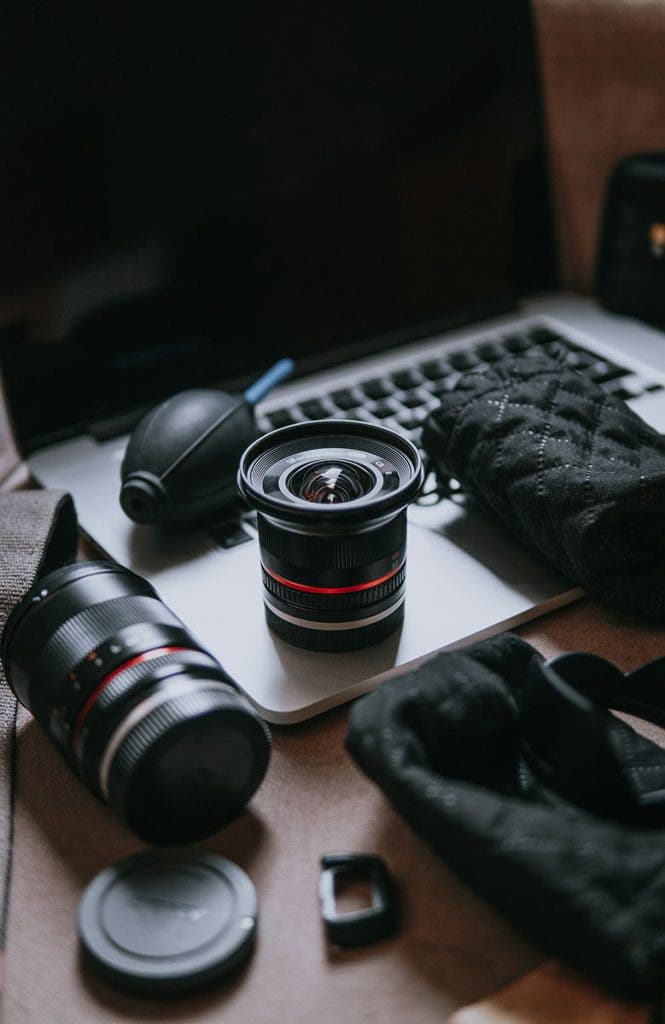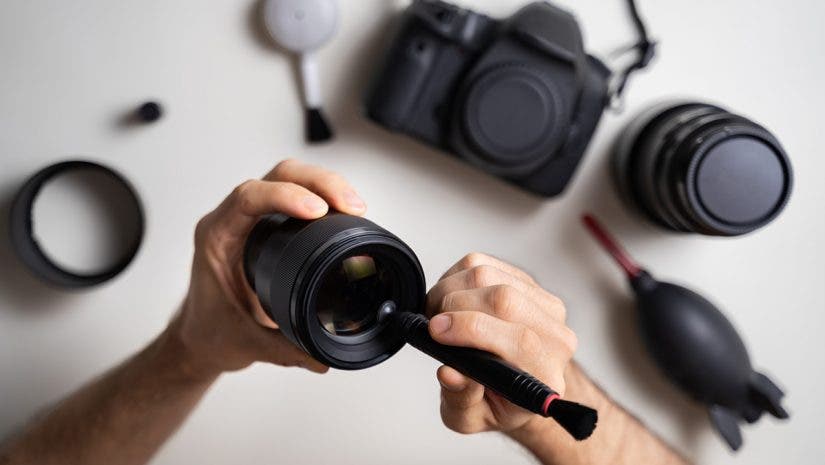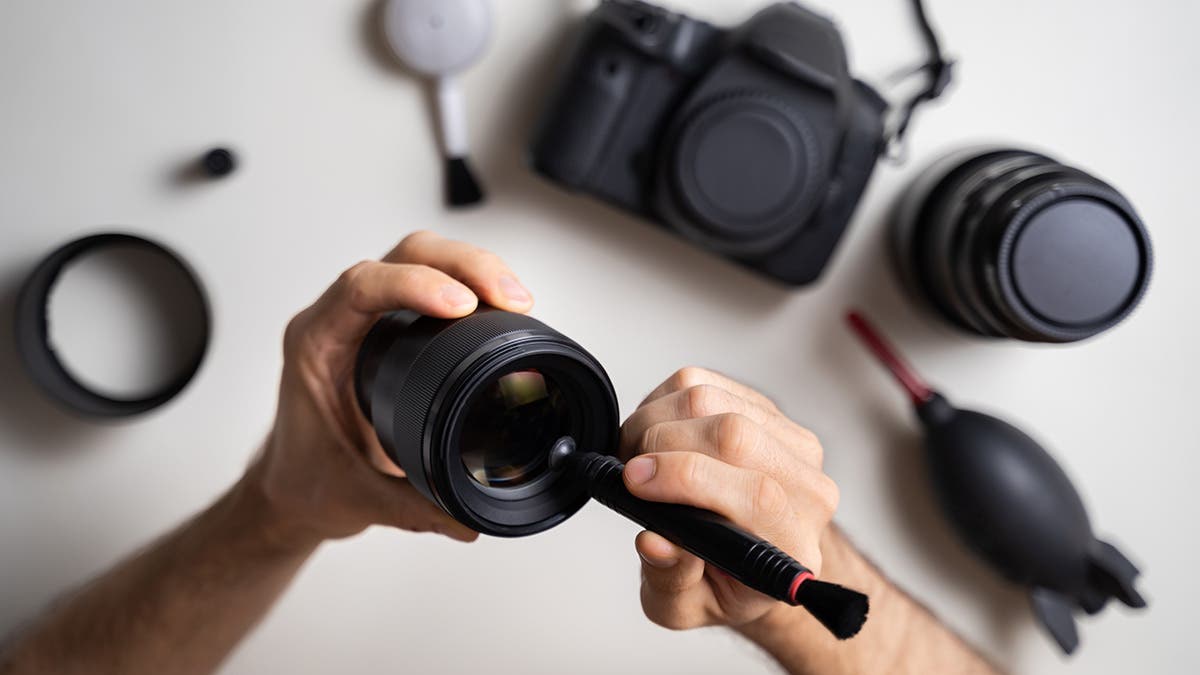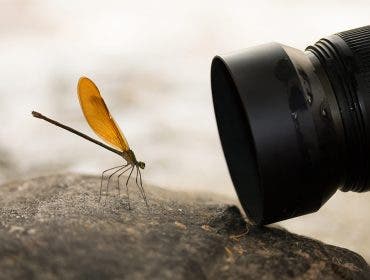The condition of your camera lenses is one of the major factors that affect image quality. Clean lenses help produce sharp and crisp photos. Also, they tend to last longer than dirty lenses, for obvious reasons. Thus, to help protect your camera lenses and make sure they can continuously take high quality pictures, we have put together this camera lens cleaning guide.
But first, you need to learn how to clean camera lenses properly!
Here are some of the common questions from camera owners about camera maintenance and safely cleaning DSLR camera lenses:
How do I perform a dirt test on a DSLR lens?
Checking your lenses for signs of dirt will let you know if they’re due for a routine camera-lens cleaning. Here’s how to do it:
1. Set the focus to infinity.
To be able to adjust the focus, set your camera to Manual mode. Then turn the focus ring to infinity. Doing so will allow you to see specks of dust in the viewfinder.
2. Take a photo of a plain surface.
Look for a plain surface and take a photo of it. For more accurate results, do a two-shot approach. Take a photo of both light-colored and dark-colored surfaces, so you can easily spot dust particles on the photos.
3. Examine the photos you’ve taken recently.
Put your camera in Playback mode and zoom in each image. Carefully inspect the images for any hazy spots or dust particles. If you find dirt, it’s time to clean your DSLR lens.
4. Check for other signs of a dirty DSLR lens.
Inspect the rear element of your lens for dust and smudge. Check for molds inside the lens as well. If there are molds, it’s safer to have your lens cleaned by an authorized camera cleaning personnel than to remove the molds by yourself.
What tools do I need for cleaning my DSLR camera lens?
Cleaning a camera lens is an easy and straightforward task as long as you use the right camera cleaning kit. Invest in high-quality camera cleaning tools to maintain your DSLR lenses’ excellent condition.
Here are the four must-have supplies in your camera cleaning kit:
1. Air Blower
Breathing on the lens to blow dirt away is harmful to your lens, as acids in your breath can damage lens coatings. A safer way to get rid of dust on a lens is to use a manual air blower that easily removes specks of dust.
When you’re traveling a lot or when shooting outdoors, a blower should always be in your camera bag so you’re always ready for a quick camera-lens cleaning.
2. Soft-bristled brushes
Get a soft-bristled brush made of camel or goat hair to keep your sensitive camera lens from getting scratched while you’re cleaning it. Also, avoid touching the bristles of the brush if your fingers are oily to keep your lens from getting smudged after you brush it.
3. Microfiber cloth and camera lens wipes
Camera-lens wipes should be disposed of right away after use. Reusing a camera-lens-cleaning wipe will only put the dirt back on your lens.
As for the microfiber cloth, make sure the one you’re using is clean. When you wash the cloth, never use a fabric softener because the chemicals in it may leave streaks on your lens and may damage the lens coating.
4. Cleaning fluid
A lens cleaning solution removes fingerprints and smudges without leaving any streaks. Use just the right amount of fluid—a drop or two is enough. Putting more fluid than necessary on the cleaning cloth may damage your camera’s optics, as excess fluid can flow inside it.
How do I clean a camera lens?
Here’s a simple step-by-step instruction that you can follow to clean your DSLR lenses and keep them in good condition:
- Using an air blower and a soft-bristled brush, remove as much dirt as you can.
- Add a drop or two of lens cleaning fluid to a microfiber cloth or a cleaning wipe.
- Starting from the outer part, wipe the lens in a circular motion going to the center and gently remove fingerprints, oil, smudges, dirt, and dust.
How do I keep my camera lens clean?
Now that you know how to clean your camera lens, here are some tips on how to maintain a clean camera lens.
- Don’t forget to attach the lens cap before placing your camera in a bag.
- Store the lenses in your camera bag. Avoid placing them in dusty areas.
- When you remove the lens from the camera body, make sure to attach another lens right away or put the camera cap on.
- Always attach the lens cap when you’re not using your camera.
How do I avoid getting dust on my camera lens?
Prevention is always better than a cure. Aside from taking steps to keep your lens clean, you should also make sure to minimize dust build up on it.
1. Tilt the camera down when changing lenses.
The camera and the lenses you’re switching should be facing down. This will prevent dust particles from landing on the DSLR sensor and lens optics.
2. Never use canned air.
Canned or compressed air can blast and destroy the camera sensor and the optics of your camera lens. If you feel the need to blow out dust from your lens, use a manual air blower instead. It’s much safer that way because the air from a manual blower isn’t as pressurized as canned air.
3. Wipe dirt and dust off your lens mount.
Don’t let dirt and dust particles sit on your lens mount for a long time. Wipe it clean before it sticks to the rear of your DSLR lens. Quick dirt and dust removal will decrease the chances of these particles to reach the optics of your camera lens.
How often should I clean my camera lens?
How often to clean camera lenses is just as important as how to clean camera lenses. You should only perform camera-lens cleaning as needed and as infrequently as possible. That said, some conditions may require you to clean your camera lens multiple times in a day or even multiple times during a single shoot.
When you first remove your lens cap, take a look at the front element of your lens. Do you see any dust, smudges, lint, or water spots? If so, it’s a good idea to clean your camera lens before you begin to shoot.
Before mounting a new lens to your camera, check both the front and rear lens elements. If you notice any smudges or dust on the back element of the lens, clean it before attaching the lens to your camera body. If you don’t, you may introduce debris to the inside of your camera or the sensor.
When shooting during active rain, on a windy day, or in any other conditions that may introduce smudges or foreign objects to your gear, check your lens periodically and perform a quick camera-lens cleaning as needed.
What should NOT be used to clean a camera lens?
There are so many things you shouldn’t use for cleaning a camera lens, it would be faster to list the things you can use! In any case, these are the top cleaning agents and materials to avoid:
- Abrasive cleaners
- Chemical or caustic cleaners like ammonia, bleach, glass cleaner, disinfectant, or scented cleaners with oil
- Toothbrushes or cleaning supplies with firm bristles
- Wet wipes that aren’t specifically designed for cleaning electronics
- Already dusty, dirty, or debris filled cloths and rags
- Paper towels
- Your clothing
- Lint-prone materials like tissues or toilet paper
- Squeegee devices
- Cotton swabs
- Soap
Professional camera repair and cleaning techs use lint-free tissue paper, microfiber cloths, puffs of air, and isopropyl alcohol to clean lenses and camera components. As long as your lenses are weather sealed and you use alcohol in extreme moderation, this is generally a safe practice to consider.
Never introduce moisture to the inside of your camera body, and if you’re not sure about how to best handle cleaning a camera lens, leave it up to the professionals!

How to Clean a Camera Lens: Frequently Asked Questions
Why is it important to clean your camera lens?
First of all, please note that lenses should be cleaned only as often as they need to so as to not damage any optical elements. These elements could include specialized coating such as fluorine. Dust, fingerprints, and grime, just to name a few things, can accumulate on the front element of your lens. These can not only affect the quality of your images but may actually damage the lens or the specialized coating.
Oils and foreign substances often contain minute concentrations of chemicals such as acids which, when left long enough on the lens, can lead to damage. Also, remember to use material only designed to be used to clean optical quality glass.
Camera Lens Cleaning: What could go wrong?
Always use a blower first on the surface of your lens before proceeding any further. The air will help blow away any sharp substances such as sand which can scratch your lens as you wipe with a microfiber cloth. Don’t use the wrong cleaning solution. Only use solutions especially made for lens surfaces. Random solutions may contain chemicals that are harmful to the lens coating. If you don’t have a proper solution, you can wet a microfiber cloth with a small amount of pure water and use that to wipe the lens.
Avoid using a generic, coarse brush on your lens. Use a soft tip lens brush or lens-cleaning pen. A coarse brush can scratch the lens coating. Also, avoid touching the bristles with your fingertips because that can leave behind oily residues which can then be transferred to the lens surface. As a final reminder, don’t use paper towels, tissue paper, or a your clothing to clean your lens. These can deposit fibers which will lead to your lens being dirtier than when you started.
Can you use rubbing alcohol to clean a camera lens?
Rubbing alcohol is Isopropyl Alcohol. It comes in various strengths (70% and 99% being the most popular). If you want to use Isopropyl Alcohol, you need to make sure there are no other chemicals such as glycerin mixed in. This can leave a filmy residue on the lens surface. Mix equal part 99% Isopropyl Alcohol and distilled water to make your own lens cleaning solution. Use a small spray bottle to apply the solution to the lens.
How do I clean a foggy camera lens?
It’s important to realize that a foggy camera lens isn’t dirt. It’s simply condensation that has accumulated on the inside surface of the lens. It won’t do permanent damage as long as it doesn’t occur frequently. Repeated episodes of condensation may lead to fungus formation, which can be devastating.
Condensation or fog occurs when there is a drastic change in temperature or humidity. You can minimize the effect by warming up the lens or storing your lens in a bag with silica gel packets. Sometimes, if the condensation has already formed, you could place the lens in front of the car heater or use a blow dryer on warm setting.
How do I clean a phone camera lens?
The coating in front of your cell phone’s camera is usually made of quite robust material. It is not nearly as fragile as the front element of “real” lens because manufacturers know people aren’t as gentle with their phones as they are with actual lenses. There are several techniques you can use to clean your phone’s camera.
As with a traditional lens, you can use a microfiber cloth to wipe away fingerprints and grime. For more stubborn substances, applying a thin coat of lens cleaning fluid (e.g., eye glass cleaner) before wiping might do the trick. If you don’t have some water or cleaning solution immediately at hand, you can simply blow some of your hot breath on the lens and then wipe away with your shirt. If you feel the need, you could stick a clear protector on the lens. Several are available online. Choose one that is completely clear.
Finally, if you notice any stubborn scratches that are affecting the quality of your images, try applying a thin layer of children’s toothpaste to the lens surface. Rub gently in a circular motion with a soft microfiber cloth and wash it away with completely with warm water. You’ll be amazed how effective this method can be.
Learn more about camera lens cleaning in this AdoramaTV video:
Conclusion
Your DSLR lenses are an expensive investment. To make your every penny count, you must take good care of them. Maintain your DSLR lenses’ excellent condition, so you can take high-quality photos for a long time. Prioritizing a clean camera lens will save you time and hassle in the long run.
Between uses, store your lenses and other camera gear in a sealed bag, pouch, or case. Products like lens wraps, lens sleeves, lens pajamas, and microfiber towels are great option for protecting your lenses between uses from moisture and debris.
If you want to ensure your gear remains moisture-free during storage, consider adding a desiccant pack to the bottom of your camera bag. Change it out every month or so, or after extremely humid excursions or weather conditions to ensure your gear stays dry.
Photographers who find themselves regularly cleaning smudges off the front elements of their lenses may want to consider hydrophobic, scratch-resistant filters for added protection.






